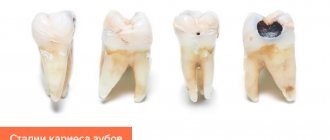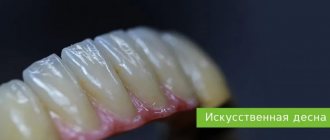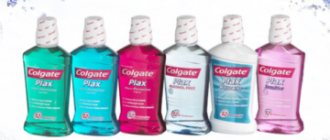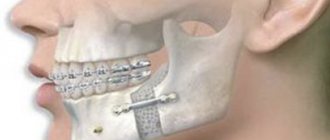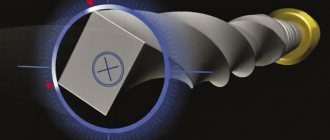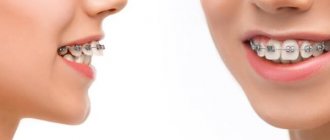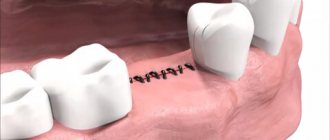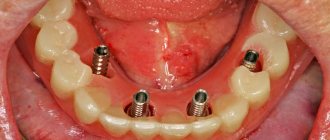Composition and application of microprosthesis
Compound
The prosthetic structure consists of a pin part that completely follows the shape of the root canal, and a stump that imitates the crown being restored. Most often, stump inlays are made from various metal alloys through precision casting. However, zirconium or aluminum oxide can also be used to produce prostheses.
Application
Standard cast pins are used to create tooth stumps with pronounced destruction of their supragingival part and the presence of healthy, strong roots. In this case, the tab is tightly fixed in the root canal so that its stump part protrudes above the gum. The stump can be used as a support for crowns, splinting structures, removable and fixed dentures.
In modern dental practice, collapsible and non-removable stump inlays are used.
Non-removable structures are used to restore teeth with one root, and collapsible ones are used to create tooth stumps with two or more roots.
Orthopedic treatment of tooth crown defects using inlays
For several decades, the search for optimal ways to replace defects in the crown of the tooth has been ongoing. The development of technology constantly tilts the scales, which tilts towards either therapeutic or orthopedic techniques. Our goal was not to conduct a comparative analysis of various methods for restoring crown defects. This publication is devoted only to illustrating certain recovery methods that, in our opinion, deserve attention.
The main method of eliminating defects in the crown of a tooth, especially in the initial and middle forms, is undoubtedly filling. Dental filling compared to prosthetics is a less labor-intensive process, which consists of surgical removal of the affected tissue, medicinal treatment of the cavity and filling the defect with filling material. However, this method of treatment, even at the modern level of development of dentistry, cannot always provide a solution to the problem of restoring the shape and function of teeth, especially with carious defects of classes II, IV of the Black classification, systemic hypoplasia, increased abrasion, hereditary disorders and malformations of hard tissues, etc.
The significant and most characteristic disadvantages of fillings include, first of all, secondary caries and loss of fillings (Abolmasov N. G. et al., 2003). M. B. Bushan and V. N. Kopeikin note that filling materials have a lower coefficient of wear resistance compared to metal and porcelain. They may be porous and not strong enough. Therefore, interest in alternative types of treatment and, in particular, in replacing tooth crown defects with inlays is quite justified.
Inlays are called microprostheses used to restore defects in the coronal part destroyed as a result of carious and non-carious lesions. Unlike a filling, the tab is inserted into the prepared cavity not in a plastic state, but in a solid state. This avoids shrinkage that occurs when the filling material hardens, and therefore improves the marginal fit and reduces the frequency of caries relapses.
The design of the inlay is selected taking into account the topography, shape, size of the defect, anatomical and topographic relationships of hard and soft tissues, type of bite, direction of loads, tooth inclination, radiographic results, presence or absence of pulp. Depending on the material from which the inlays are made, they are divided into: a) metal (gold 900, 750, cobalt-chrome alloy, silver-palladium alloy, titanium alloys, for example VT5L); b) non-metallic (porcelain, composite); c) combined metal-ceramic and metal-composite (Fig. 1).
Rice. 1a. Inlay made of 900-carat gold alloy.
Rice. 1b. Inlay made of 900-carat gold alloy.
For a number of years, the main structural material for inlays has been gold alloys. The method of manufacturing a cast inlay using a wax model was described by Taggart in 1907. Since then, the technology has undergone certain changes, but the high strength characteristics and accuracy of the fit of the gold inlays to the walls of the cavity, maintaining a constant volume, protecting the edges of the enamel from chipping, inertness, non-oxidation in the oral cavity, the ability to unravel during chewing and better adapt to the walls of the cavity.
In connection with the increasing requirements for the aesthetics of restorations and constantly improving technologies for the manufacture of dentures, one of the most promising areas is the prosthetics of partial defects in the coronal part of the tooth with ceramic inlays. The current level of development of dentistry makes it possible to produce these structures in the following ways:
- firing on foil;
- firing on a fireproof model;
- production of a ceramic frame by firing on a refractory model, followed by cladding;
- production of ceramic inlays by pressing;
- manufacturing a frame from aluminum oxide and zirconium dioxide by electrophoretic deposition with subsequent lining;
- manufacturing the inlay frame by ultrasonic condensation of aluminum oxide with the addition of zirconium dioxide, followed by layer-by-layer application and firing of porcelain;
- firing of the aluminum oxide frame followed by cladding;
- milling using a computer program.
The technology for manufacturing ceramic dentures by hot pressing is implemented using the IPS-Empress I, II systems. One of the advantages of these systems is the use of fluorapatite as a structural material, which, compared to other ceramic materials, causes less abrasion of natural antagonist teeth (Fig. 2).
Rice. 2a. Porcelain inlay made by pressing (painting technique).
Rice. 2b. Porcelain inlay made by pressing (painting technique).
Initially, the IPS-Empress I system provided for the complete reconstruction of the anatomical shape of the coronal part of the tooth from wax and the subsequent simultaneous hot pressing of the ceramic mass. Thus, the finished restoration was monochrome, with a high degree of transparency, since porcelain of the same color was used. Color correction was carried out by applying dyes before glazing, which did not always make it possible to optimize the color rendition of the restoration with the individual coloring characteristics of natural teeth (coloring technique).
Ivoclar specialists continued to work on this issue, which was reflected in their later developments. When working with the IPS-Empress II system, you can create a wax model of the base of the inlay with subsequent pressing. Subsequently, dentin and enamel masses are applied to the model on the frame, ceramics are modeled and fired (layer-by-layer porcelain application technique).
The manufacture of the inlay frame by ultrasonic condensation of aluminum oxide with the addition of zirconium dioxide, followed by layer-by-layer application and firing of porcelain involves the introduction of a suspension of the VITA In-Ceram ZIRCONYA material into the cavity of the double model of the prepared tooth, compacted in a Vita Sonic II type apparatus, drying, and correction of the shape of the inlay base , glass infiltration and firing. After trying on the base in the oral cavity, it is veneered with ceramic mass (Fig. 3).
Rice. 3a. Ceramic inlay made using ultrasonic condensation technology of VITA In-Ceram ZIRCONYA material, followed by firing and layer-by-layer application and firing of ceramics.
Rice. 3b. Ceramic inlay made using ultrasonic condensation technology of VITA In-Ceram ZIRCONYA material, followed by firing and layer-by-layer application and firing of ceramics.
Rice. 3c. Ceramic inlay made using ultrasonic condensation technology of VITA In-Ceram ZIRCONYA material, followed by firing and layer-by-layer application and firing of ceramics.
The most interesting direction may be related to milling a ceramic block using a computer program. Since the early 90s, zirconium oxide has been increasingly used in dentistry. According to in-vitro studies, zirconium oxide denture frames have high tensile strength comparable to that of metal alloys. The introduction of CAD/CAM technology in dental prosthetics makes it possible to produce structures with high accuracy and predictably reproducible quality. Based on the general user algorithm and hardware layout, CAD/CAM systems can be divided into 3 main groups:
- Centralized macrosystems (Procera, Decim).
- Individual mini-systems (Hint-Els, Precident).
- Custom microsystems (Cerec).
The use of modern computer technologies can significantly increase the accuracy of restoration manufacturing and minimize the influence of the human factor. However, most of the well-known CAD/CAM systems are expensive, which limits their distribution in the dental market. A number of inventors set out to create compact and inexpensive milling equipment that makes it possible to produce extended structures from zirconium oxide (Fig. 4).
Rice. 4a. Manufacturing of inlays using copy-milling technology and a zirkonzahn machine.
Rice. 4b. Manufacturing of inlays using copy-milling technology and a zirkonzahn machine.
Rice. 4c. Manufacturing of inlays using copy-milling technology and a zirkonzahn machine.
Rice. 4g. Manufacturing of inlays using copy-milling technology and a zirkonzahn machine.
One of them was Enrico Steger, inventor, owner and CEO of Zirkonzahn. The operation of his system is based on copy-milling technology. First, a prototype of the product is created from a light-curing composite material, then it is milled from a zirconium oxide blank in a copy-milling machine.
To facilitate this process and reduce wear on grinding tools, the Zirkonzahn machine works with an unsintered (pre-agglomerated) form of zirconium dioxide. The zirconium oxide inlay blank is 25% larger than the composite counterpart, since further firing of the product will lead to significant shrinkage of the material. The author managed to calculate these volumetric changes and transfer them with high accuracy into the basis of the operation of his copy-milling machine.
Along with the above-described methods for making inlays, restoration of defects in the coronal part of the tooth is also currently used using inlays made of light-curing composite materials. Compared to porcelain and metal-ceramic inlays, composite inlays have a less abrasive effect on natural teeth; due to the elasticity of the composite, they absorb part of the occlusal load, are less labor-intensive to manufacture and do not require expensive bulky equipment and specially trained dental technicians, and can be easily restored in the oral cavity. , much cheaper.
The disadvantages of composite inlays include insufficient color stability, the possibility of allergic reactions to the composite, and the abrasion of modern composite materials, although close to the abrasion of tooth enamel, is somewhat higher, which can lead over time to a decrease in the height of the lower third of the face in the position of central occlusion with multiple restoration of lateral teeth, with single restorations - to the development of deformation of the occlusal curves. Composite inlays have lower strength, greater porosity, and, compared to porcelain and metal ones, are characterized by less tolerance to the gingival margin, but despite this, they can be a serious alternative to direct restorations (Fig. 5).
Rice. 5a. Stages of tooth restoration using a composite inlay.
Rice. 5 B. Stages of tooth restoration using a composite inlay.
Rice. 5th century Stages of tooth restoration using a composite inlay.
Rice. 5g. Stages of tooth restoration using a composite inlay.
Rice. 5d. Stages of tooth restoration using a composite inlay.
Rice. 5e. Stages of tooth restoration using a composite inlay.
The development of dentistry at the present stage is characterized by the rapid growth of new technologies for the manufacture of dentures. And it’s quite difficult for a dentist to navigate this diversity. We hope that this publication expands the horizons of choosing restoration techniques for defects in the coronal part of the tooth.
LITERATURE
- Abolmasov N. G. Replacement of defects of teeth and dentition with fixed dentures N. G. Abolmasov, N. N. Abolmasov, V. A. Bychkov, V. R. Shashmurina. - Smolensk, 1995. - 175 p.
- Bragin E. A. Fundamentals of microprosthetics. Pin structures of dentures, inlays, veneers, artificial crowns, decorative dental onlays. / E. A. Bragin, A. V. Skryl. - M.: Medical press, 2009. - 508 p.: ill.
- Volvach S.I. CAD/CAM technologies in the dental laboratory - myth or reality? / S. I. Volvach // New in dentistry for dental technicians. - 2000, No. 4 (12). - P. 3-13.
- Dyakonenko E. E. Orthopedic treatment with metal-free ceramics as an alternative method of tooth restoration / E. E. Dyakonenko // New in dentistry for dental technicians. - 2000, No. 1 (9). - P. 3-14.
- Prosthetic restoration of teeth. CEREC system. Textbook, ed. prof. V. N. Trezubova, S. D. Arutyunova. - St. Petersburg: Spetslit, 2003. - 64 p.
- Skryl A.V. Restoration of defects in tooth crowns with ceramic inlays / A.V. Skryl // Modern orthopedic dentistry. - 2008, No. 10. - P. 46-48.
- Steger E. ZIRKON milling technology / E. Steger // Dental technician. - 2007, No. 4. - P. 33-41.
Indications and contraindications for the installation of stump inlays
Indications for installation
Restoring teeth with core inlays is possible only if there is firm confidence in the reliability of the root and in the absence of any pathological processes in the periodontal tissues. The length of the root canal into which the cast post is installed must be greater than the height of the artificial crown, and the walls of the tooth must be thick enough to withstand the chewing load.
Contraindications for use
The main contraindications to prosthetics with stump inlays are:
- obstruction of the root canal or its curvature;
- pronounced changes in periodontal tissues in the absence of the ability to block the development of the pathological process;
- improper root length or tooth wall thickness;
- pathological mobility of teeth;
- incomplete filling of root canals.
Anchor pins for tooth restoration
Anchor pins are often used to restore pulpless teeth. Anchor pins are metal pins that are fixed into a canal to build a tooth stump for a future crown or direct restoration.
They are threaded and fixed into the root canal using special cement. At one time they were very widely used in dentistry. However, they soon began to be abandoned, and we tried to figure out why.
Positive and negative properties of anchor pins
If we talk about the advantages of using anchor pins for restoration, they include:
- strength - such pins do not break
- affordable price
- speed and ease of use
What's wrong then? Let's look at all the shortcomings:
- low connection - there is no chemical connection between the intra-root and coronal parts, so they can easily separate
- poor aesthetics, especially if the work is done on the front teeth
- high risk of root fracture, since when installing an anchor pin, tension occurs inside the tooth root, which leads to a wedging effect, plus necrosis of the tissue around the tooth root, which leads to tooth extraction
The speed of installation of the anchor pin also plays an unpleasant role here. Fast does not mean easy. After all, each anchor pin system has its own installation rules and special auxiliary tools, which, unfortunately, are often neglected.
Stages of manufacturing and installation of cast pins
Prosthetics with core inlays involves a number of clinical and dental measures. In particular, the main steps in the manufacture and installation of cast pins are:
- preparing a damaged tooth for installation of a stump inlay (unsealing the root canals by 2/3 of their length, preparing the tooth aimed at eliminating possible undercuts);
- taking a two-layer silicone impression from both jaws;
- covering the prepared tooth with a temporary filling (crown);
- transfer of the silicone impression to the dental department;
- making a plaster model based on the cast made;
- modeling a cast wax pin;
- casting of the prosthetic structure in the dental department;
- transfer of the finished cast pin from the dental laboratory to the dentist;
- fitting and fitting of the prosthesis;
- final installation of the core inlay and its fixation using dental cement (glass ionomer is most often used) or dual-curing composite.
- After fixing the cast pin, a suitable crown or prosthetic structure is installed on the stump.
Types of tabs
Depending on the material of manufacture, they come in the following types:
- metal-ceramic
- the most budget-friendly; - ceramic
– the most aesthetic; - made of zirconium dioxide
- the most durable.
These microprostheses are also classified depending on their position in the tooth. According to this criterion, the following varieties are distinguished:
- Inlay
– the hole in the tooth is box-shaped, the inlay is installed inside it; - Onlay
– the overlay has an external side; - Overlay
– only one wall is preserved, the overlay replaces almost the entire crown; - Pinlay
– the inlay has additional cavities or pin inclusions for better fixation.
The type of inlay based on its position in the tooth is selected by the dentist after an initial consultation.
Advantages and disadvantages of prosthetics with stump inlays
Prosthetics with cast pins, just like any other dental procedure, has a number of advantages and disadvantages.
Benefits of Tabs
The positive features of using core inlays to restore damaged teeth are:
- the possibility of completely restoring the natural shape of the replaced crown (lateral enamel ridges on its chewing surface, cusps, etc.);
- rapid normalization of the functions of the masticatory apparatus;
- monolithic structure (no risk of separation of the stump and pin);
- tight fit of the prosthesis to the root surface (minimizing wedging load).
Disadvantages of microprostheses
The main disadvantages of orthopedic dental treatment with cast pins include:
- the need for extensive preparation of the damaged tooth;
- long lead times for the manufacture and installation of a prosthetic structure (the presence of a laboratory stage, during which the pin is cast by a dental technician);
- high cost of stump inlays compared to standard pins.
Contraindications
This type of microprosthesis cannot be installed in the following cases:
- bruxism (grinding teeth in sleep);
- steep slopes of hillocks;
- rapidly progressing caries;
- deep cavity extending into dentin;
- inability to ensure complete dryness of the field.
A relative contraindication is poor oral hygiene. In what cases is it not advisable to use:
- A cavity less than 1.5 mm deep (you can get by with a filling);
- The damage has affected the cervical area of the tooth (the inlay will no longer help);
- The tooth is more than 60% destroyed (a crown is required);
- Milk tooth. It makes no sense to restore it using an inlay, since the life of the tooth is less than the durability of the microprosthesis. In addition, a vlkadka costs much more than a filling. Spending so much money to restore a tooth that will soon fall out is not advisable.
Erosion
Looks like areas of damaged enamel with a changed shade. In the affected areas, during erosion, hard tissues soften, gradually collapse, and a cavity is formed that reaches the dentin. At this stage, the tooth begins to hurt, react to any irritants, and the defect itself becomes clearly visible. Erosion has several possible causes:
- frequent consumption of sour or sweet foods;
- brushing teeth with hard brushes or pastes with an abrasive effect;
- low calcium content in hard tissues (due to metabolic disorders, pregnancy, certain diseases).
Erosion looks like a spot with a smooth, non-shiny surface. It is treated by performing remineralization and tooth restoration. It is important to find and eliminate the cause of the defect. If this is not done, erosion will appear in new places.
Let's sum it up
When a carious lesion occurs, it is important to understand why dental inlays are needed, why they are better than a composite filling, and when they are contraindicated. It is important to understand that installing such structures is not always advisable and in some cases can lead to complications, which are much more difficult to get rid of than preparing a cavity and pouring filling material into it or installing a microprosthesis on cement.
Before starting treatment, you need to choose a good doctor who will prescribe diagnostic procedures, carefully study the research results and give recommendations during the recovery period. Although almost the entire process is automated, the participation of a professional orthopedist is the key to quality therapy without unpleasant consequences.
Specialists provide a full range of dental and orthopedic services, advise patients and offer optimal solutions to problems. Sign up for a consultation by phone or leave a request on our website, and we will contact you as soon as possible.
Hypoplasia and hyperplasia
These are rare congenital pathologies. With hypoplasia, the enamel is underdeveloped or absent altogether. With hyperplasia, its quantity, on the contrary, is excessive. Such disorders arise due to metabolic failure, general pathologies of fetal development, diseases of the gastrointestinal tract, as well as health problems that arise in women during pregnancy. Usually the problem of hyper- and hypoplasia is solved in childhood by removing “extra” or replenishing missing hard tissues. Sometimes those who had congenital hypoplasia may require more frequent remodeling therapy in adulthood.
Injury
The tooth may become damaged due to trauma, and this requires urgent treatment. Usually these are chips, fractures or dislocations that occur due to impacts, accidental falls, or gnawing on hard objects. If the defect as a result of injury is superficial (it is a small chip), it is enough to restore the hard tissues by performing a restoration. If it is a severe bruise, crack, or fracture, more serious recovery will be required. If you quickly consult a dentist, the tooth will most likely be saved (there are such chances even if it was knocked out). In the most severe cases, removal is required, and then implantation and prosthetics are performed.

